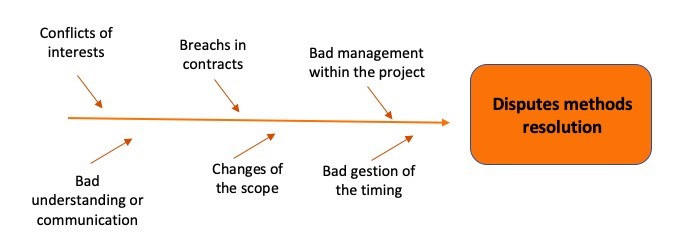Which methods to choose to minimize impacts?
STUDENT PAPER
By Marguerite Simon
SKEMA Business School
Lille, France
INTRODUCTION
As international contracts become ever more important in our society, the resulting litigations about disputes and conflicts follow the same path. Indeed, if the number of contracts signed continues to grow exponentially, disputes which are related to them do the same but the consequences on projects are real. International contractors need to study this current problem in order to avoid them as much as possible.
The disputes appear in international contracts in different ways. One contracting party or nation can don’t respect the terms of a contract and create a conflict or a breach which parties need to resolve quickly[1]. A dispute can also appear by conflicts of interests between two or more parties. Most disputes are very important, so it is even hard to solve it easily. In these cases, parties are often helped by an external person or organisms. Disputes are an important subject in international contracts because the consequences of them are relevant. These problems are related to breaches which can make lose money, time, credibility, productivity or energy for both parties[2]. The stakes are important. A dispute can hamper the good development of one project, even if stop it quickly[3]. Understanding the importance of this topic, methods have been developed to avoid this widespread phenomenon to expand themselves[4] . The aim of these processes is to avoid conflicts before their apparition. To avoid conflict, Steven Pinnell invites us to think about better project management, dispute avoidance through partnering, effective claims management procedures or firm but fair legal strategy and tactics.

Figure 1: Root-cause analysis
However, even disputes are very widespread and important in international contract. When these situations occur, the contracting parties tend to use, firstly formal methods of resolution namely ask service of a judge in a court where a trial will settle an agreement. It is the most formal dispute resolution methods called the litigation. Thanks to a trial and the work of an impartial judge, a binding agreement will be found between the two contracting parties in opposition.
However, this kind of classic resolution of conflict can be a very costly, complicated and lengthy process[5]. Parties tried to find others way of resolution that we will called alternative disputes resolutions methods. They are informal alternatives methods to litigation[6]. These kind of practice of conflict resolutions methods are the most used processes because parties can control the processes and the solutions themselves.
This type of conflict resolution method appears in reaction of the weaknesses of formal methods. Actually, many international contractors are fed up with formal ways of resolutions. Consequently, alternative disputations resolutions methods arise. They are defined by Cornell Law School such as « any method of resolving disputes without litigation »[7]. The school adds that the validity of these ADR methods can still be reviewing by public courts. The particularity of those methods is the presence of an independent third person who helps contracting parties to resolve their disputes and find a common agreement. Namely, voluntary or mandatory, those processes of alternative dispute resolutions are the mediation, the arbitration, the conciliation, the amical expertise, the neutral evaluation, Dispute Review Board, or the settlement conferences…[8]. According to the Planning Planet website there are six feasible alternatives to resolving conflicts. If these methods have the same purpose, it is to say, find an agreement between two contracting parties in conflict, they are differentiated by the role and missions of an external actor. This third person who appears can be a mediator, a conciliator, an evaluator, a judge…
More…
To read entire paper, click here
Editor’s note: Student papers are authored by graduate or undergraduate students based on coursework at accredited universities or training programs. This paper was prepared as a deliverable for the course “International Contract Management” facilitated by Dr Paul D. Giammalvo of PT Mitratata Citragraha, Jakarta, Indonesia as an Adjunct Professor under contract to SKEMA Business School for the program Master of Science in Project and Programme Management and Business Development. http://www.skema.edu/programmes/masters-of-science. For more information on this global program (Lille and Paris in France; Belo Horizonte in Brazil), contact Dr Paul Gardiner, Global Programme Director paul.gardiner@skema.edu.
How to cite this paper: Simon, M. (2019). Disputes in international contracts: which methods to choose to minimize impacts? PM World Journal, Vol. VIII, Issue IV (May). Available online at https://pmworldlibrary.net/wp-content/uploads/2019/05/pmwj81-May2019-Simon-Disputes-in-International-Contracts.pdf
About the Author

Marguerite Simon
Lille, France
![]()
Marguerite Simon is a student with a double degree between Sciences Po Aix and Skema Business School. At Science Po she is pursuing a master’s degree in International Expertise and at Skema Business School she is currently in Msc Project and Program Management and business development. As part of her studies, she spent a year in Canada, in Montreal. This year abroad allowed him to improve his knowledge of political science. In addition to these courses, Marguerite works in an automotive consulting firm. She is currently working on Prince 2 and Agile PM certifications for this semester.
Marguerite Simon can be contacted at marguerite.simon@skema.edu
[1] Pinto, J. K. & Kharbanda, O. P. (1995). Project management and conflict resolution. Project Management Journal, 26(4), 45–54. Retrieved from https://www.pmi.org/learning/library/project-management-organizational-conflict-resolution-2035
[2] NSW Government, Types of alternative dispute resolution, Retrieved from : http://www.courts.justice.nsw.gov.au/Pages/cats/courtguide/alternate_dispute_resolution/types_adr/types_adr.aspx
[3] PP Admin (2012, February). Guild of project controls comprendium and reference (CaR), Retrieved from : http://www.planningplanet.com/guild/gpccar/formal-disputes-resolution
[4] Steven Pinnell. (2018, December). Dispute Management Partnering, Claims Management and Dispute Resolution. Retrieved from: http://www.planningplanet.com/guild/library/dispute-management-partnering-claims-management-and-dispute-resolution
[5] Find Law, (2017, May) What is Alternative Dispute Resolution, Retrieved from : https://hirealawyer.findlaw.com/choosing-the-right-lawyer/alternative-dispute-resolution.html
[6] California Court, The judicial Branch of California, ADR Types & benefits. Retrieved from : http://www.courts.ca.gov/3074.htm
[7] Tala Esmaili. (2017, June) Alternative dispute Resolution, Cornell Law School. Retrieved from https://www.law.cornell.edu/wex/alternative_dispute_resolution
[8] CMAP, Alternative dispute resolutions methods, Retrieved from http://www.cmap.fr/our-offer/alternative-dispute-resolution-methods/?lang=en









